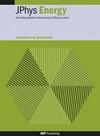通过化学修饰操纵无粘结剂激光粉末床熔融加工制备的固态电解质的离子电导率
IF 6.3
3区 材料科学
Q1 ENERGY & FUELS
引用次数: 0
摘要
固态电池的增材制造可通过增加电池组件(如电极和电解质)的几何复杂性来提高功率密度。本研究采用激光粉末床熔融(L-PBF)增材制造方法制备了块状三维 Li1+xAlxTi2-x(PO4)3(LATP)电解质样品。在 LATP 中添加了 Li3PO4 (LPO),以补偿加工过程中的锂蒸发。化学成分包括 0、1、3 和 5 wt.得出的离子电导率值范围为 1.4 × 10-6-6.4 × 10-8 S cm-1,其中化学成分为 3 重量% LPO 的样品离子电导率值最高。对每种化学成分的微观结构特征都进行了仔细测量,并将其与离子电导率相互关联。这些特征及其相应的范围包括:孔隙率(从 5% 到 19%)、裂纹密度(0.09-0.15 mm mm-2)、残留 LPO 的浓度(0%-16%)以及次生相 AlPO4(11%-18%,0.40-0.61 µm)和 TiO2(9%-11%,0.50-0.78)的浓度和 Feret 直径。微观结构特征与离子导电率之间的相关性从-0.88 到 0.99 不等。裂纹密度与离子电导率之间的负相关性最强(-0.88),这证实了加工缺陷在限制块状固态电解质性能方面的重要作用。AlPO4 浓度与离子导电率(0.99)之间的正相关性最强,这是因为 AlPO4 起到了烧结辅助剂的作用,并在降低裂纹密度方面发挥了作用。我们的研究结果表明,添加 LPO 可以平衡相互竞争的微观结构特征,从而设计出具有更好离子传导性的块状三维 LATP 样品。因此,细化化学成分为改善固态电池应用中使用无粘合剂激光增材制造技术制备的功能陶瓷的可加工性和性能提供了一种可行的方法。本文章由计算机程序翻译,如有差异,请以英文原文为准。
Manipulating ionic conductivity through chemical modifications in solid-state electrolytes prepared with binderless laser powder bed fusion processing
Additive manufacturing of solid-state batteries is advantageous for improving the power density by increasing the geometric complexity of battery components, such as electrodes and electrolytes. In the present study, bulk three-dimensional Li1+x
Al
x
Ti2−x
(PO4)3 (LATP) electrolyte samples were prepared using the laser powder bed fusion (L-PBF) additive manufacturing method. Li3PO4 (LPO) was added to LATP to compensate for lithium vaporization during processing. Chemical compositions included 0, 1, 3, and 5 wt. % LPO. Resulting ionic conductivity values ranged from 1.4 × 10−6–6.4 × 10−8 S cm−1, with the highest value for the sample with a chemical composition of 3 wt. % LPO. Microstructural features were carefully measured for each chemical composition and correlated with each other and with ionic conductivity. These features and their corresponding ranges include: porosity (ranging from 5% to 19%), crack density (0.09–0.15 mm mm−2), concentration of residual LPO (0%–16%), and concentration and Feret diameter of secondary phases, AlPO4 (11%–18%, 0.40–0.61 µ m) and TiO2 (9%–11%, 0.50–0.78). Correlations between the microstructural features and ionic conductivity ranged from −0.88 to 0.99. The strongest negative correlation was between crack density and ionic conductivity (−0.88), confirming the important role that processing defects play in limiting the performance of bulk solid-state electrolytes. The strongest positive correlation was between the concentration of AlPO4 and ionic conductivity (0.99), which is attributed to AlPO4 acting as a sintering aid and the role it plays in reducing the crack density. Our results indicate that additions of LPO can be used to balance competing microstructural features to design bulk three-dimensional LATP samples with improved ionic conductivity. As such, refinement of the chemical composition offers a promising approach to improving the processability and performance of functional ceramics prepared using binderless, laser-based additive manufacturing for solid-state battery applications.
求助全文
通过发布文献求助,成功后即可免费获取论文全文。
去求助
来源期刊

Journal of Physics-Energy
Multiple-
CiteScore
10.90
自引率
1.40%
发文量
58
期刊介绍:
The Journal of Physics-Energy is an interdisciplinary and fully open-access publication dedicated to setting the agenda for the identification and dissemination of the most exciting and significant advancements in all realms of energy-related research. Committed to the principles of open science, JPhys Energy is designed to maximize the exchange of knowledge between both established and emerging communities, thereby fostering a collaborative and inclusive environment for the advancement of energy research.
 求助内容:
求助内容: 应助结果提醒方式:
应助结果提醒方式:


